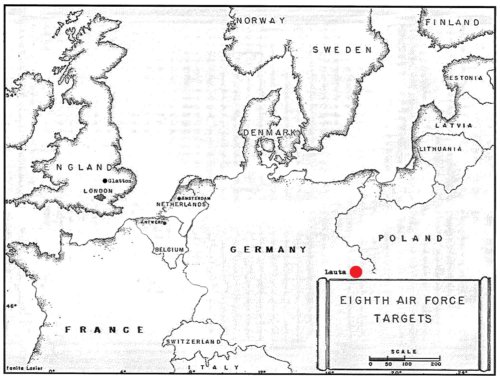TARGET: OIL PLANT
LAUTA, GERMANY
12 SEPTEMBER, 1944
Eight combat wings of the 1st Division were dispatched against oil targets in the Ruhland area. The 457th Bomb Group comprised the 94th A Combat Wing with Major Francis as Air Commander and Lt. Brackley as pilot, leading a thirty-six ship formation.
Taking off into a hazy, but cloudless atmosphere, the Group left the English coast, flying the route as briefed across the North Sea. Landfall was made on the west coast of the Schleswig-Holstein. The planes headed southeast to a point northeast of Berlin where they turned south toward the IP. The Group following was at a higher altitude, and because of a difference in wind, was having a problem over running the 457th. They turned to the right just before the turning point near Berlin, causing them to come under heavy anti aircraft fire from Berlin. They turned left to get out of that, and in so doing swung their low box through the high box of the 457th, scattering their formation.
The Luftwaffe chose that opportunity to attack, and shot down a number of the other Group’s low box. Some of the 457th’s formation was attacked by the 30 to 50 FW-190s, but the following wing bore the brunt of the damage and six to eight of their planes were destroyed. Most of the attacks were made from the tail, both high and low. Enemy aircraft were persistent in closing in and following crippled craft down with continuous fire.
The 457th plane piloted by Lt. Hany H. Selling was attacked by fighters. The tail came off, the craft exploded and only Lt. Selling survived.
As the formation continued to the IP, the Group turned on the bomb run. All three boxes dropped on what was believed to be the primary target, but which later was learned to be the aluminum works at Lauta. Good results were reported. Existing clouds had made it impossible to locate the target area until the formation was halfway down the bomb run.
Flak encountered was persistent, moderate, accurate and of the tracking type. Sixteen craft sustained damage. Death by anoxia claimed one crew member.
Gunners claimed two enemy fighters were destroyed. Lt. Lauren M. Spleth’s crew, on its first mission, had two engines out in the target area, trailed on the bomb run, and dropped bombs short of the target. They eventually managed to maintain altitude at about 13,000, and arrived safely back at Glatton about an hour behind the rest of the Group.
From the diary of 751st BS gunner Sgt. Albert G. Williams:
“Fifth mission completed today. The target was Ruhr Valley and, Germany, near Dresden. A long run. Our box was hit by 190’s Harry Selling, flying our left wing (no. 3 position) went down in flames when fighters came in on his tail.”
Lt. Edwin B. Benson, 457th/749th bombardier: Mission 6. Ruhland. Oil Plant. Time 9.30. High, FLAK & Fighters.
